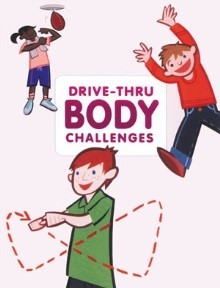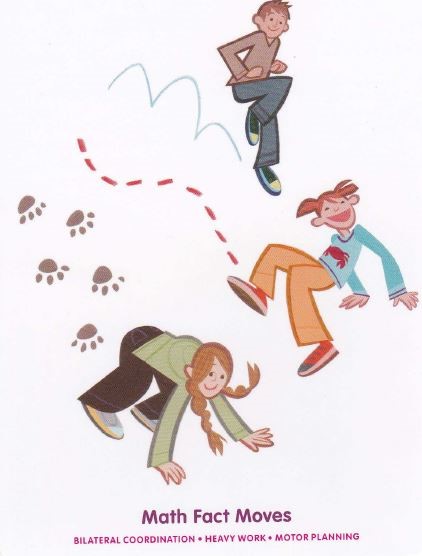 The 2018 Saturday Seminar Series kick-off on January 20 featured June Smith, OTR/L’s presentation: Specialized Brain Gym and Building Block Activity Workshop. June is a full-time clinician and mentor at South Shore Therapies in Massachusetts and is a specialist in sensory integration (SIPT certified), NDT, ocular-motor dysfunction and visual-vestibular treatment. She is a certified Brain Gym instructor and a provider for the Therapeutic Listening Program. June teaches nationally on Brain Gym and Integrated Learning Concepts to support stress-free learning and efficiency of the ocular-motor system.
The 2018 Saturday Seminar Series kick-off on January 20 featured June Smith, OTR/L’s presentation: Specialized Brain Gym and Building Block Activity Workshop. June is a full-time clinician and mentor at South Shore Therapies in Massachusetts and is a specialist in sensory integration (SIPT certified), NDT, ocular-motor dysfunction and visual-vestibular treatment. She is a certified Brain Gym instructor and a provider for the Therapeutic Listening Program. June teaches nationally on Brain Gym and Integrated Learning Concepts to support stress-free learning and efficiency of the ocular-motor system.
Brain Gym empowers; it supports alerting and quieting using a total of 26 exercises that require only one tool – your body. June displayed a Venn diagram that aptly described Brain Gym as interlocking concepts that involve 1). a series of simple body movements that 2). integrate all areas of the brain and 3). enhance learning and self-esteem. To demonstrate these concepts with the group, June led us in an alerting activity called “thinking cap.” She feels it is a powerful way to begin a session to facilitate engagement. We started by turning our heads to the right, then left, to examine any tension in our necks. We were asked to massage our ears simultaneously by unrolling the fold of the outer ear, moving from top to bottom. We then were asked to turn our heads again to see if we felt a decreased amount of tension compared with our pretest. Most agreed that head turning was less restricted after “thinking cap.”
 June demonstrated a variety Brain Gym exercises that are used in the “PACE” process, an acronym for Positive, Active, Clear, and Energetic,” beginning with Energetic and working in reverse sequence (ECAP) because each of the four activities prepares you for the next. June described it as a ladder, working your way upward toward the top. She demonstrated three exercises that involved arm activation, the first assisted by using a Gertie Ball for arm extension to maintain internal rotation; a “double doodle” where one hand mimics the other, and “lazy 8s” in which the hand traces a large horizontal figure 8, crossing midline of the body using a Race the 8s large marble maze or Trace the 8s, that is based on the infinity sign. She offered suggestions for adapting the exercises for different populations to ensure success.
June demonstrated a variety Brain Gym exercises that are used in the “PACE” process, an acronym for Positive, Active, Clear, and Energetic,” beginning with Energetic and working in reverse sequence (ECAP) because each of the four activities prepares you for the next. June described it as a ladder, working your way upward toward the top. She demonstrated three exercises that involved arm activation, the first assisted by using a Gertie Ball for arm extension to maintain internal rotation; a “double doodle” where one hand mimics the other, and “lazy 8s” in which the hand traces a large horizontal figure 8, crossing midline of the body using a Race the 8s large marble maze or Trace the 8s, that is based on the infinity sign. She offered suggestions for adapting the exercises for different populations to ensure success.
Several publications from Therapro were endorsed by June today including: Fraid Not: Empowering Kids with Learning Differences, by occupational therapist Pam Formosa; The Learning Gym, and Drive Thru Menus Attention & Strength (New Edition) and Drive Thru Menus Calming and Stress Busting (New Edition), by occupational therapist Tere Bowen-Irish.
June presented an interactive, stimulating seminar today that supported the philosophy that Brain Gym stimulates movement based learning. It incorporates simple, gentle movements that activate brain function. There has been much research conducted on how movement positively influences the brain and our health, and Brain Gym is a powerful tool that helps put a student in the best possible frame for learning as they become calm and organized.
Here’s what attendees had to say about June’s seminar:
“Great information! June convinced me.” – Lise S., Occupational Therapist
“Very informative, lots of practical ways to apply, fabulous ideas. Can’t wait to practically apply these strategies.” – Christin M., Occupational Therapist
“Great presenter. Very informative and interactive! FUN! – Susan P., Physical Therapist
“Fabulous. Recharged my OT battery to use in my school sessions. Used to do Brain Gym daily, changed school districts & haven’t been using.” – Jodi D., Occupational Therapist
Thank you, June!
Filomena Connor, MS, OTR/L
January 20, 2018

 Many children with or without SPD LOVE deep, heavy pressure experiences and movement. This includes children on the autism spectrum or those with other types of developmental disabilities. One very simple strategy is to provide some type of “dynamic seating”. This simply means that the child can bounce, wiggle, rock or move around in some other way while seated. Many teachers incorporate seat cushions and ball chairs in the classroom to help students focus. The Disco Seat is one popular product. An inexpensive alternative is to sit on a deflated ball, as I am doing in the photo. Don’t have one available while eating out or sitting in the movie theater? Consider rolling up a sweatshirt for the child to sit on or curl up inside of to get a full body squeeze.
Many children with or without SPD LOVE deep, heavy pressure experiences and movement. This includes children on the autism spectrum or those with other types of developmental disabilities. One very simple strategy is to provide some type of “dynamic seating”. This simply means that the child can bounce, wiggle, rock or move around in some other way while seated. Many teachers incorporate seat cushions and ball chairs in the classroom to help students focus. The Disco Seat is one popular product. An inexpensive alternative is to sit on a deflated ball, as I am doing in the photo. Don’t have one available while eating out or sitting in the movie theater? Consider rolling up a sweatshirt for the child to sit on or curl up inside of to get a full body squeeze.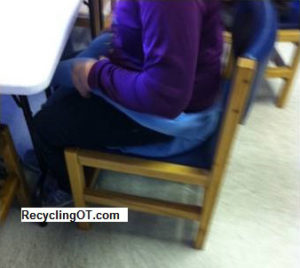 Speaking of sweatshirts, I have had great success in helping a young lady named Judy to be more focused and less agitated by placing a Disco Seat cushion inside the body of a sweatshirt. The photo shows Judy sitting on the cushion, enjoying some gentle bounces with the sleeves slung over her lap.
Speaking of sweatshirts, I have had great success in helping a young lady named Judy to be more focused and less agitated by placing a Disco Seat cushion inside the body of a sweatshirt. The photo shows Judy sitting on the cushion, enjoying some gentle bounces with the sleeves slung over her lap. The sleeves are heavy because I put bags filled with sand inside of them. Next I sewed the wrist and shoulder ends of the sleeves closed so that the bags wouldn’t fall out. This adaptation can be used in a various of ways. The sweater may be placed over the back of a chair so that the heavy sleeves are draped over the child’s shoulders and body. Placing the cushion inside the sweater is optional.
The sleeves are heavy because I put bags filled with sand inside of them. Next I sewed the wrist and shoulder ends of the sleeves closed so that the bags wouldn’t fall out. This adaptation can be used in a various of ways. The sweater may be placed over the back of a chair so that the heavy sleeves are draped over the child’s shoulders and body. Placing the cushion inside the sweater is optional.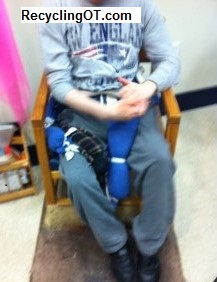 Seat cushions and lap bags that are a lot nicer than the ones I make with a deflated ball, sand and plastic bags are sold by
Seat cushions and lap bags that are a lot nicer than the ones I make with a deflated ball, sand and plastic bags are sold by 
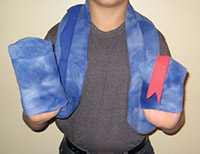
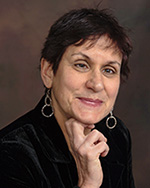 Barbara A. Smith has worked with children and adults with developmental disabilities for over 40 years! She is the author of the Recycling Occupational Therapist, From Rattles to Writing: A Parent’s Guide to Hand Skills and From Flapping to Function: A Parent’s Guide to Autism and Hand Skills. Learn more about her work at
Barbara A. Smith has worked with children and adults with developmental disabilities for over 40 years! She is the author of the Recycling Occupational Therapist, From Rattles to Writing: A Parent’s Guide to Hand Skills and From Flapping to Function: A Parent’s Guide to Autism and Hand Skills. Learn more about her work at 